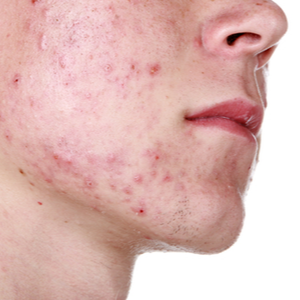Quick Links

Often mistaken for a skin condition that is exclusive to teenagers, particularly among boys in their postpubescent years, acne can in fact strike at men and women of all ages. It is estimated that acne affects almost ten percent of the population, placing it in the top ten of all diseases worldwide! The condition can be both embarrassing and painful but can be controlled with the appropriate treatment.
The full medical term for this widespread condition is acne vulgaris. Vulgaris is the Latin word for “common”, while the term acne refers to sharp points or pimples. Another skin condition that can be prefaced by the word acne is acne rosacea. This is a separate condition and it is sometimes confused with acne vulgaris, but it is treated in a different way.
Other forms exist, but they are less common than acne vulgaris. These include:
- Acne conglobata: a severe form of mature-onset acne that occurs mainly in men whose testosterone levels are abnormally high,
- Acne inversa: a condition that primarily affects the armpits and groin
- Acne keloidalis nuchae: a specific form occurring on the scalp, particularly among men of African descent. It is often associated with short-cropped or shaved hair which aggravates the skin.
Acne originates within the pores or hair follicles of the skin. It is most commonly found on the face (chin, forehead, cheeks, jawline, nose, and around the mouth) but can also appear on the back and the chest.
Acne pimples are distressing, but untreated acne can lead to inflammation, infection of the pores, the development of pustules, nodules, and even large cysts. Skin becomes pock-marked and scarred, with scars persisting long after the underlying cause has faded.
People who suffer from acne vulgaris can be very self-conscious of their condition, particularly in social situations. This can lead to psychological problems including anxiety and depression.
The good news is that acne is manageable, especially if it is treated early and managed well. Call 330.725.0569 or come into Trillium Creek Dermatology – we have a full range of treatments to combat your condition and lessen the chance of scarring. We are serving the following communities and those surrounding: Wooster, Wadsworth, Medina, Brunswick, Strongsville, and Hinkley.
Causes of Acne
Acne is most often induced by hormonal changes, primarily an increase in androgen production. Each hair follicle within the skin has a gland that produces oil. This is an entirely natural process, but when oil production becomes excessive in response to hormone changes it can cause dead skin cells to clump together in the oil rather than shed from the skin. The pores become filled with this debris which darkens through exposure to the air (oxidation). This is commonly referred to as a blackhead or “comedone”.
Sometimes the oil and skin debris will effectively close the pore by plugging it completely. Because air cannot get to the debris to darken it, a whitehead is formed. Bacteria thrive in this environment, causing pimples and inflammation. Left untreated, scarring can occur.
When tissues become injured, the body rushes to repair the injury site. Among the elements of the repair are white blood cells and inflammatory molecules that have the task of repairing tissue and fighting infection. When their job is done, they may remain at the site of an active lesion for days or even weeks. In people who are susceptible to scarring, the result may be a scar in the form of fibrous or eroded tissue. Two types of scars exist: depressed areas and raised thickened tissue known as “keloids”.
It’s a myth that only teenagers or those with unclean habits or junk food addictions get acne. It is true that most of the people we treat at Trillium Creek Dermatology are young adults, but we frequently treat cases in mature adults as well.
Because of the link with hormonal changes, it is understandable that most teenagers are likely to develop some level of acne during puberty. Hormonal changes can also lead to outbreaks among women during pregnancy.
There has been considerable research about whether certain foods cause acne. One thing the scientists do know is that they don’t know for sure! There is evidence that processed or refined carbohydrates and certain dairy products can stimulate acne, but the best advice seems to be that if you think a particular food is aggravating your condition, try cutting it out for a few weeks to see if your condition improves.
Your Team of Experts
Acne Treatment
There are over-the-counter topical treatments available for cases of mild acne and, when used according to directions, these topical acne spot treatments can provide an effective remedy. Mild cleansing routines and face masks can also provide some relief.
For moderate to advanced cases, however, and for those not responding to conventional treatment, you may require prescription medication. The best acne treatment for you will be prescribed by your Trillium Creek Dermatology skin expert.
Topical Therapy
Effective treatments are available both over-the-counter and by prescription only.
Over-the-counter topical treatments include:
- benzoyl peroxide: a mild antibiotic available in various concentrations,
- sulfur-based products: effective in treating existing pustules, and
- salicylic acid: also effective in treating existing blackheads and whiteheads.
Prescription topical treatments include:
- Retinoid cream: a common, effective treatment used to unclog swollen pores and maintain clear skin,
- Erythromycin and clindamycin: antibiotic creams used to kill the bacteria that leads to inflammation, and
- Sulfacetamide: an antibiotic often combined with sulfur, that opens clogged pores and is effective in treating inflammatory acne.
Accutane is one of the most effective oral medications for acne. It is a vitamin A, which shrinks the sebaceous gland. It halts the production of the natural oil that causes acne. The side effects associated with this product require the patient to follow detailed guidelines.
Oral Antibiotics & Vitamins
Antibiotics are effective in reducing bacteria and fighting inflammation for moderate to severe cases. They include tetracycline, doxycycline, and minocycline.
Certain vitamins can also play a key role in fighting acne. Vitamin A, vitamin E, zinc nicotinamide, selenium, and magnesium have all been shown to prevent or minimize acne outbreaks. Some vitamins can be harmful in large doses, and many carry unwanted side effects. Your Trillium Creek skin expert will advise you on the safest, most effective amounts to take for relief.
Oral Hormones/Birth Control Pills
Birth control pills and oral hormones are very effective for acne in women when hormonal imbalance is the root cause. There is a wide range of formulations representing different combinations of estrogen and progestin. Your Trillium Creek skin expert will work with you to find the right combination to reduce the frequency and severity of outbreaks.
Acne Laser Treatments and Cosmetic Procedures
There are several cosmetic procedures available, including laser treatments that can greatly minimize acne and lessen the chance of scarring.
The following are among the procedures available:
- Aerolase®
- ALA/PDT
- BLU-U/Blue Light
- Botox®/ Dysport
- Chemical Peels
- eMatrix™
- HydraFacial
- Intense Pulsed Light (IPL)
- Red Light
- Skin Needling



